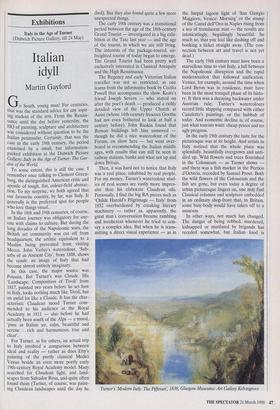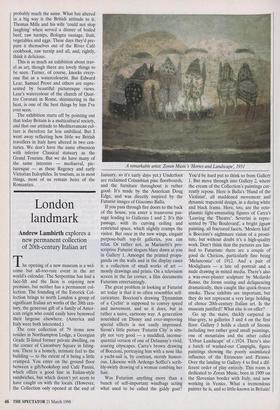Exhibitions
Italy in the Age of Turner (Dulwich Picture Gallery, till 24 May)
Italian idyll
Martin Gayford
G. South, young man! For centuries, that was the standard advice for any aspir- ing student of the arts. From the Renais- sance until the day before yesterday, the HQ of painting, sculpture and architecture was considered without question to be the Italian peninsular. Certainly, that was the case in the early 19th century, the period examined by a small, but information- packed exhibition at the Dulwich Picture Gallery: Italy in the Age of Turner: The Gar- den of the World. To some extent, this is still the case. I remember once talking to Clement Green- berg, the distinguished American critic and apostle of tough, flat, colour-field abstrac- tion. To my surprise, we both agreed that our favourite country, by far, was Italy. It generally is the preferred spot for people who love things visual. In the 18th and 19th centuries, of course, an Italian journey was obligatory for any- one with claims to culture. But during the long decades of the Napoleonic wars, the British art community was cut off from headquarters, the artistic equivalent to a Muslim being prevented from visiting Mecca. John Varley's watercolour, 'Sub- urbs of an Ancient City', from 1808, shows the result: an image of Italy that had become almost entirely imaginary.
In this case, the major source was Poussin. But Turner's was Claude. His `Landscape: Composition of Tivoli' from 1817, painted two years before he set foot in Italy, looks nothing much like Tivoli, but an awful lot like a Claude. It has the char- acteristic Claudean mood Turner com- mended to his audience at the Royal Academy in 1811 — also before he had actually been south of the Alps — a mood, `pure as Italian air, calm, beautiful and serene ... rich and harmonious, true and clear'.
For Turner, as for others, an actual trip to Italy involved a comparison between ideal and reality — rather as does Etty's painting of the portly classical Medici Venus beside an even more portly early 19th-century Royal Academy model. Many searched for Claudean light, and land- scapes from Salvador Rosa, and quite often found them (Turner, of course, was paint- ing Claudean landscapes until the day he died). But they also found quite a few more unexpected things.
The early 19th century was a transitional period between the age of the 18th-century Grand Tourist — investigated in a big exhi- bition at the Tate last year — and the age of the tourist, in which we are still living. The interests of the package-toured, air- freighted tourist of today began to emerge. The Grand Tourist had been pretty well exclusively interested in Classical Antiquity and the High Renaissance.
The Regency and early Victorian Italian traveller was not so restricted, as one learns from the informative book by Cecilia Powell that accompanies the show. Keats's friend Joseph Severn — who stayed on after the poet's death — produced a richly detailed view of the Upper Church at Assisi (whose 14th-century frescoes Goethe had not even bothered to look at half a century before). John Ruskin found that Roman buildings left him unmoved though he did a nice watercolour of the Forum, on show here — but went over- board in recommending the Italian middle ages, with results that can still be seen in railway stations, banks and what not up and down Britain.
Then, it was hard not to notice that Italy was a real place, inhabited by real people. For my money, Turner's watercolour stud- ies of real scenes are vastly more impres- sive than his elaborate Claudean oils. Personally, I find the big RA pieces such as `Childe Harold's Pilgrimage — Italy' from 1832 overburdened by creaking literary machinery — rather as, apparently, the great man's conversation became rambling and incoherent whenever he tried to con- vey a complex idea. But when he is trans- mitting a direct visual experience — as in the limpid lagoon light of 'San Giorgio Maggiore, Venice; Morning' or the stump of the Castel dell'Ovo in Naples rising from a sea of translucent mist — the results are intoxicatingly, beguilingly beautiful. So much so, that you feel like dashing off and booking a ticket straight away. (The con- nection between art and travel is not yet dead.) The early 19th century must have been a marvellous time to visit Italy, a lull between the Napoleonic disruption and the rapid modernisation that followed unification. Venice, for example, around the time when Lord Byron was in residence, must have been in the most tranquil phase of its histo- ry. It then was a decaying backwater under Austrian rule; Turner's watercolours record little shipping compared with either Canaletto's paintings, or the hubbub of today. And economic decline is, of course, just what tourists want: cheap prices and no ugly progress.
In the early 19th century the taste for the picturesque was at its height. And artists in Italy noticed that the whole place was splendidly, beautifully overgrown and unti- died up. Wild flowers and trees flourished in the Colosseum — as Turner shows and there was a fish market in the Portico d'Octavia, recorded by Samuel Prout. Both the wild flowers of the Colosseum and the fish are gone, but even today a degree of urban picturesque lingers on, one may find Classical columns and sculpture embedded in an ordinary shop-front that, in Britain, some busy-body would have taken off to a museum.
In other ways, not much has changed. The danger of being robbed, murdered, kidnapped or mutilated by brigands has receded somewhat, but Italian food is Turner's 'Modern Italy: The Pifferari; 1838, Glasgow Museums: Art Gallery Kelvingrove probably much the same. What has altered in a big way is the British attitude to it. Thomas Mills and his wife 'could not stop laughing' when served a dinner of boiled beef, raw turnips, Bologna sausage, fruit, vegetables and eggs. These days they'd pre- pare it themselves out of the River Café cookbook, raw turnip and all, and, rightly, think it delicious.
This is as much an exhibition about trav- el as art, though there are lovely things to be seen. Turner, of course, knocks every- one flat as a watercolourist. But Edward Lear, Samuel Prout and others are repre- sented by beautiful picturesque views. Lear's watercolour of the church of Quat- tro Coronati in Rome, shimmering in the heat, is one of the best things by him I've ever seen.
The exhibition starts off by pointing out that today Britain is a multicultural society, and that our attitude to Mediterranean cul- ture is therefore far less umbilical. But I went away reflecting how little we British travellers in Italy have altered in two cen- turies. We don't have the same obsession with inferior Classical statuary as the Grand Tourists. But we do have many of the same interests — mediaeval, pic- turesque — as these Regency and early Victorian Italophiles, In tourism, as in most things, most of us remain heirs of the Romantics.





































































 Previous page
Previous page